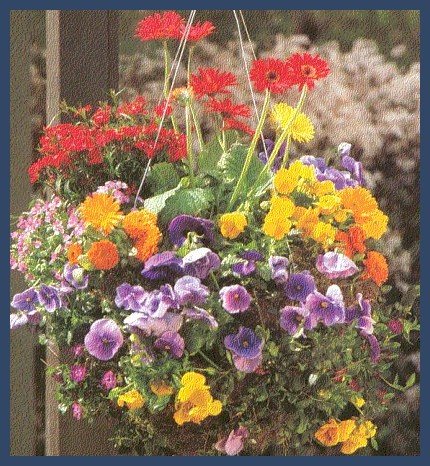
Rainbow Hanging Basket

Needs 20 inch wire basket
sphagnum moss
potting soil
fertilizer granulesSoak sphagnum moss thoroughly and line basket completely with a 1 inch thick layer of moss, pressing into the wire. In a bucket mix fertilizer granules and soil mixture. Hold moss in place and lightly fill basket.
8 Dwarf Periwinkles, gently separate the wire openings on the sides of the hanging basket to plant these. Vinca grows best in hot conditions - full sun, heat and high humidity. ( great plant for the southern U.S. area.) Flowers are pretty pink or white and like warm, rich, well drained soil. Avoid over watering to prevent soil borne disease. Propagate by seed, these will often self seed. Sow seeds 12 weeks prior to setting out after last frost.
Germination is 12-14 days with temperatures at 70 degrees F.
Butterflies love this plant! Easy to care for. We have these in our garden beds and it is a joy!
12 Pansies, plant pansies the same as you did the periwinkles, saving 1/2 the pansies to a plant around rim to finish the basket. Pansies grow on sprawling plants that flower continuously as they grow. Flowers can range from 2 to 5 inches or larger. There is a variety of color to choose from. In mild winter areas plant as soon as weather cools in late summer, or as soon as ground can be worked in early spring. If plants become leggy or lanky, shear back half way to force new growth and bloom. Pansies prefer sun and moist, cool soil. A bit of shade will help extend their growing season in hot climates. Propagate by seed 6-8 weeks before planting outdoors. Germinate in 10-15 days at 68 degrees F. DO NOT COVER SEEDS, they need light to germinate. From personal experience I have found that planting these in the same spot several years in a row they will start to reseed themselves in warmer climates, but the flowers will not be as big.
Plant where ever you want spots of color, rock garden , front of borders or beds and in with other flowers.
1 Dianthus, divide the center of the pot into 3 imaginary sections, place this in 1 of the centers. This plant is a genus of evergreen , or semi evergreen mainly summer flowering perennials, annuals and bi-annuals, grown for their mass of flowers, often scented, some of which are excellent for cutting.
Works well in borders, beds, and rock gardens. Needs open sunny position and well drained slightly alkaline soil.
Propagate by seed. Also known as Sweet William.
2 Gerber Daisies; also known as the Transvaal or Barbert or Daisy since its comes from the south African province and Barberton for the city there. A perennial that is too tender to live through winter except in zones 9-10. ( personal note here: I live zone 7 and it does survive the winters here.) Will bloom form seed the 1st year. A nice rosette of notched glossy leaves with flowers that grow 12-18 inches high depending on the variety. Flowers are single, semi-double or double shades of pink, orange, red, yellow and white and are up to 4 inches in diameter.
Grows best in full sun, but will tolerate partial shade. Needs, moist, drained soil, high in organic matter and high humidity. Plant after last frost, using started plants, in level warmed ground.
Propagate by seed, but do not cover; they need light to germinate. Takes 10 days to germinate at 70-75 degrees F. Sow 14-18 weeks before setting out. Best to buy a plant at nursery. Well worth the money.
4 Dwarf Calendulas - position as fillers. A genus of annual and evergreen shrubs. Annuals are hardy, shrubs are frost tender, min. 39 degrees F ( 4 c). Grow in sun and well drained soil. Deadhead to prolong flowering. These bold orange flowers on compact plants, have lance shaped, strongly aromatic, pale green leaves. Daisy like single and double flower heads are produced from spring - autumn.
Propagate annuals by seed outdoors, in spring or autumn. Shrubs by cutting in Spring . Annuals may self seed. Height and spread 2 feet.
Cucumber virus and mosaic mildew may cause problems.
1 Rockcress, use as a filler. A trailing perennial that burst into glorious bloom in April and May. Originally from Greece and Sicily, its named after French botanical artist Claude Aubriet.
Rockcress are creeping and trailing plants with small simple leaves, covered with tiny hairs. They bear a wealth if 3/4 inch wide 4 petaled flowers that grow to a height of 4 to 6 inches in a variety of blues, lilacs and purples. Leaves are evergreen when given some snow cover, but will turn brown without it.
Prefer good soil, full sun and perfect drainage. Will also do well in some shade and a very lean soil mix, with a good deal of sand. Can be cut back after blooming.
Propagate by division, seed or cuttings.
Rockcress are good for rock gardens, pockets of stonewalls, trough gardens and as edging in borders.